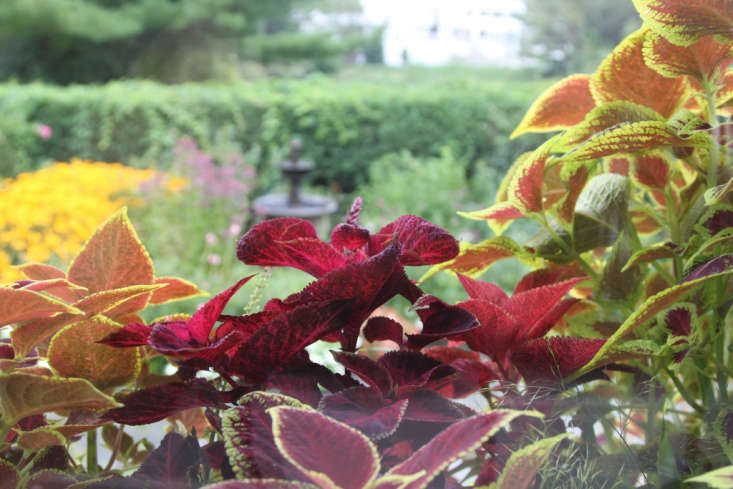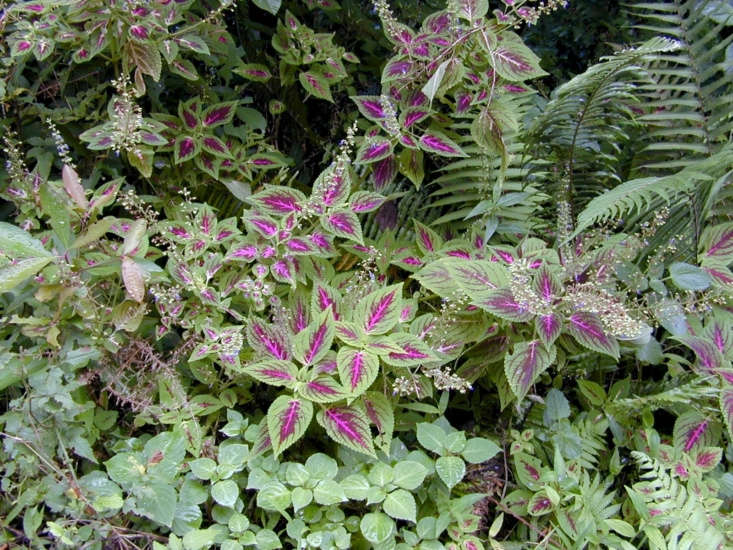Coleus: Plectranthus scutellarioides
Is coleus a plant you have to learn to love? Garden trends ebb and flow—and bright, dramatically colored foliage can be an acquired taste. I used to dismiss these tropical plants because I thought their brightly tinged leaves screamed gaudiness and were unbelievably hard to mix with other flowers. No longer. Now I think of them as plant gems that can add a burst of dramatic color; whenever I spot them I snap them up for my clients’ container plantings.
Is coleus the right plant to add to your garden beds or containers? Keep reading to find out:

Coleuses are native to tropical areas of Southeast Asia, India, Africa, Australia, and predominantly Indonesia and Sri Lanka. Knowing where a plant originates helps gardeners better understand and predict what will make it happy in other regions.

Coleus is considered a tender annual, hardy only to Zone 10, and should be incorporated into gardens with that factor in mind. But don’t despair, because in frost-prone climates coleus can be dug up, potted, and brought indoors without difficulty to be kept on a sunny windowsill through winter. Another option is to take tip cuttings in early fall to start new plants. Bonus: Coleus is one of the easiest plants to propagate. In fact, the plants root so readily that you can simply start cuttings in a glass of water.

Another good-to-know fact about coleus is that it belongs to the mint family (Lamiaceae), and possesses the tale-tale square stems and opposite leaves like its other family members. Coleus, thankfully, does not have the crazy invasive growth habit that characterizes mint and instead is well-mannered in the garden.
Coleus comes in stunning variations of chartreuse, green, pink, red, maroon, and many shades in between. Plus, some varieties are marbled or brightly edged and some are splashed. Traditionally coleus was considered a shade plant, but new varieties have hit the market which are quite tolerant of sun. With these sunny introductions plus new color combinations, habits, and even unique leaf shapes, no matter what kind of garden you have, you can find a coleus that works.

Cheat Sheet
- There is a diversity of leaf color, shape, and growth habit among coleuses, making them fantastic container and bedding plants, especially tucked into shady, drab areas or as pot fillers under large shade trees. Look for the habit that you need as some grow in an upright form, others mound, and some creep or trail.
- In container gardens, include a coleus with contrasting colors to offset a nearby plant.
- Coleus flowers are attractive to hummingbirds and can help lure them into the garden.

Keep It Alive
- All coleuses need fertile, well-draining, and evenly moist soil. Newly planted coleuses especially like to be pampered with moisture.
- Plant in shade or partial shade, though many varieties can also tolerate sun so read the plant label to confirm.
- It is recommended that the summer blooms be pinched off when they appear because they detract from the leaf display and it is thought that the flowers cause the plant to loose vigor and slip into decline. And while the flowers are not unattractive, they are ho-hum.
- Routinely pinching back the fast-growing foliage is also highly recommended to encourage branching and full, compact growth.
See more growing tips in Coleus: A Field Guide to Planting, Care & Design in our curated guides to Tropical Plants 101. See more ideas for tropical gardens or plantings:
- Before & After: A $5,000 Garden Makeover in St. Augustine, Florida
- Gardening in Paradise: 10 Ideas to Steal from Key West
- Bromeliads: A Field Guide to Planting, Care & Design
- Everything You Need to Know About ZZ Plants








Have a Question or Comment About This Post?
Join the conversation